12 results
Astronomy scaffolded notes for Easel Activities

Tides (cut and paste) Activity
This is a sorting activity on basic information about tides (high, low, spring and neap). It includes illustrations and information about causes, water levels, when each tide occurs and the moon phase.Students cut, sort and paste information then answer summary questions.Use this activity in an interactive notebook or as a formative assessment / Exit Ticket.An Easel digital activity is included. This can be used for distance learning or assigned as practice on any Learning Management System (LMS
Subjects:
Grades:
6th - 8th
Also included in: Science Interactive Notebook - Space Unit
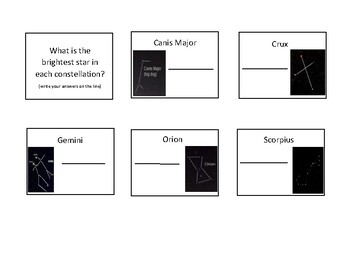
Absolute Magnitude Activity
Students will compare the absolute magnitude of stars within the same constellation. The magnitude chart that I used is included (in the preview section). This is a noninformative way to get students to understand how to read the absolute magnitude of stars. Students will make tabs out of the boxes.
Subjects:
Grades:
8th - 12th
Types:
Also included in: Constellations

Ancient Astronomy Gallery Walk
Students are expected to research and describe the use of astronomy in ancient civilizations such as the Egyptians, Mayans, Aztecs, Europeans, and the native Americans. I have also included the Muslim and Chinese civilizations. Students will be able to get a better understanding of ancient civilizations. I normally print two pages per sheet for the interactive and write the questions on chart paper and post the pictures on the chart paper. The pictures are in the preview section.
Subjects:
Grades:
8th - 12th
Types:
Also included in: Ancient Astronomy Bundle
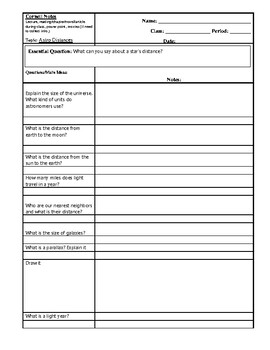
Distances in Space Cornell Notes
Students will better understand a parsec, light year, or an astronomical unit. This product is used for scaffolded notes. You could use this at any point of the lesson cycle. Students are give several questions and I would recommend using the free presentation (located in the preview).
Subjects:
Grades:
8th - 12th
Types:
Also included in: Distances in Space

FREE Scale of the Universe Cornell Notes #10
Students fill in a Cornell (2 column) Notes Outline that includes Key Terms, Questions and Summary prompt about how astronomers measure distances in space (parallax, light year) and scientific notation practice questions.Includes:Both Standard (8.5 x 11) and Composition notebook sizesSuggested Resources and Answer KeyAn Easel activity (This can be used for distance learning or assigned on any Learning Management System (LMS) or device. It can also be used as a model in the classroom by clicking
Subjects:
Grades:
6th - 8th
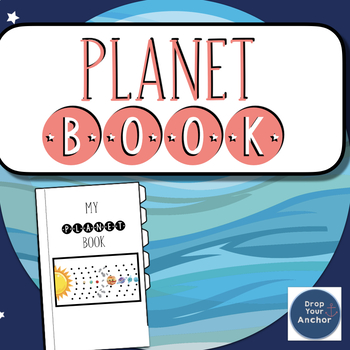
Planet Activity Fact Book
Planet activity: flip-book! This easy to assemble planet fact book is the perfect way for your students to learn about the planets! Just print, cut, & assemble!Included is• everything you need to create small planet fact books• informative fact cards with information your students need to fill the pages out You may be interested inMoon Unit and ActivitiesPlanet PostersSpace ActivitiesSpace Word WallSee all science resources here!Follow me for information about new products, freebies, and inf
Subjects:
Grades:
3rd - 5th
Also included in: Space Unit
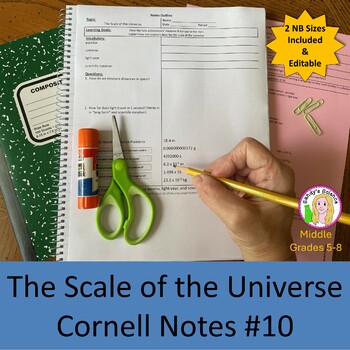
Scale of the Universe Cornell Notes #10 (editable)
Students fill in a Cornell (2 column) Notes Outline that includes Key Terms, Questions and Summary prompt about how astronomers measure distances in space (parallax, light year) and scientific notation practice questions.Editable Includes both Standard (8.5 x 11) and Composition sizesIncludes Suggested Resources and Answer KeyRelated Resources:⭐ Planet Relative Size Anchor Charts⭐ Scale Model of the Solar System⭐ Scale of the Universe Vocabulary (Frayer Model)⭐ Scale of the Universe Exit TicketT
Subjects:
Grades:
6th - 8th
Also included in: Science Interactive Notebook - Space Unit
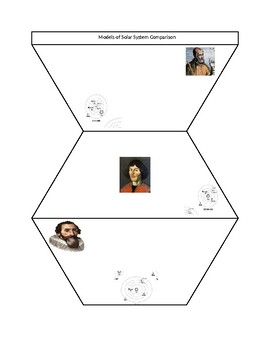
Models of Solar System Comparison Foldable
This product allows students to compare the three models of the "solar system". Students will research and compare Ptolemy's geocentric model, Copernicus' heliocentric model and Kepler's elliptical model. This foldable puts all of these concepts in one place. Students will write their notes around the pictures and identify each scientist. Can be used as scaffold notes and organizes students thoughts. Can be taught with the contributions of scientist TEKS. (ASTRO 4B: research and describe the con
Subjects:
Grades:
8th - 12th
Also included in: Contributions of Scientist
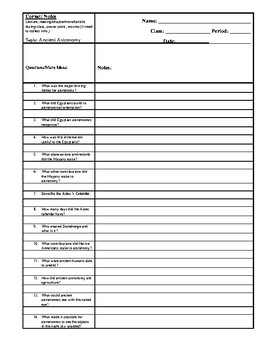
Ancient Astronomy Cornell Notes
Students are expected to research and describe the use of astronomy in ancient civilizations such as the Egyptians, Mayans, Aztecs, Europeans, and the native Americans. These cornell notes will help simplify and organize students' research and description of ancient civilizations. The presentation is also enclosed for free (combined online PPTs). I normally print the slides out, but I might post it online so students can have a reference.
Subjects:
Grades:
8th - 12th
Types:
Also included in: Ancient Astronomy Bundle
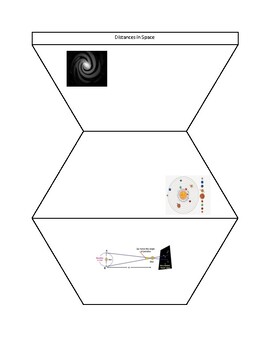
Distances in Space Foldable
This product is a type of formative assessment and it checks for understanding. You could use this at any point of the lesson cycle. Students will have to figure out which picture applies to a parsec, light year, or an astronomical unit. They will then have to give a brief description of each. As a result, students will better understand the use of units of measurement in astronomy, including Astronomical Units and light years.
Subjects:
Grades:
8th - 12th
Also included in: Distances in Space

Types of Constellations Comparison Foldable
This product allows students to compare the three types of constellations. Students will research and compare circumpolar, zodiac, and seasonal constellations. This foldable puts all of these concepts in one place. Students will write the description/ definition around the pictures. Can be used as scaffold notes and organizes students thoughts.
Subjects:
Grades:
8th - 12th
Also included in: Constellations

Comparing Solar System Models
This product allows students to compare as well as identify the three models of the solar system. This graphic can be drawn inside of students' journals and can be used as a reference page. My students liked this format and I told them to keep their information as simple as they wanted it. students should also illustrate the differences in the models. The students will understand how various scientist influenced our model of the solar system. ASTRO 4(B): Students will research and describe the c
Subjects:
Grades:
8th - 12th
Also included in: Contributions of Scientist
Showing 1-12 of 12 results





